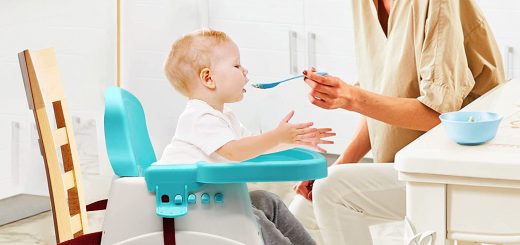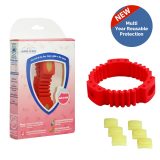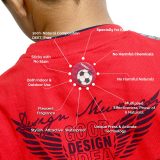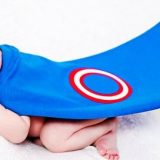Booster Seat or a High Chair or a Combination of Both – Which is Better?
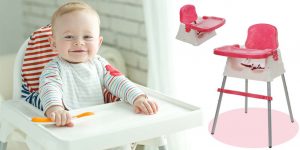
You, being a parent, are reading this because you’re going to start or have recently started feeding solid food to your baby. Congratulations on entering this beautiful, thrilling, and occasionally difficult new stage of parenting. It’s common to have a lot of questions when introducing solid foods to your infant. Parents commonly ask if a high chair or a booster seat is better for serving baby meals, or whether a combination of a high chair and a booster seat is preferable. We will cover each one separately and make it easy for you to decide which one is the most appropriate for your child.
Booster Seats
A booster seat is one of the most practical feeding solutions because it is easy to clean and allows you to reach between, around, and under locations where a feeding seat cannot. Mobility is the best attribute of booster seats. You can take it anyplace, including restaurants, parks, and homes of relatives.
Its cost is another element that makes it a more viable option than a feeding seat. They are less expensive than feeding furniture. Finally, they can be employed in conjunction with your baby’s developmental stage. That is, you can keep using the booster as your child gets older until he or she no longer requires it.
High Chair
For the vast majority of parents, it is the best seat for their child if they want them to sit at the table with the rest of the family eye-to-eye. It’s a classic child-friendly seat that’s been used to conveniently feed babies over the years. A small table and a raised seat on long legs are included in the design, allowing an adult to feed their child while standing or while sitting down to eat at the same time as the baby. This is the most convenient approach to feed a baby since it eliminates the need to hold the child in one hand while holding the food in the other, which may be a disaster if your child is a fussy eater.
When we talk about designs and styles, you will find there are plenty, including the traditional ones to portable seats and the modern ones. Based on the seller that you choose, you will find seats with extra features like superior padding and enhanced safety, among other aspects, to give your child a comfortable eating experience.
Most high chairs feature a small seat that is equipped with seat belts to keep the baby strapped in. In addition, there are some models with adjustable height features, in case your little one isn’t to suit your comfort while feeding the little one. You will also appreciate the idea of folding and storing the equipment when it is not needed as it proves to be a space-saving option.
Booster Seats and High Chair: Advantages Of Each
A booster seat is a short seat that must be attached to an existing dining chair whereas a high chair is a self-contained, tall chair that stands on its legs on the floor.
Booster Seat
Advantages
- Adaptable: If the grown-ups are used to eating on the floor, you can connect it to your dining chair or plop it on the floor.
- Portable: This is a significant benefit if you frequently eat out or travel. These seats are lightweight and easy to transport.
- Effortless to Clean: Booster seats may be easier to clean in several ways than regular seats. If your chair is particularly messy, simply take it to the bathroom and clean it. This is very good for removing food from harness belts.
- Easy to Store: It takes up less space than a high chair and maybe simply put away when not in use.
High Chair Advantages
- Broad, wide, well-built, and well-balanced
- Cleaning is slightly easier because you only have to clean one chair, as opposed to the booster seat, which may require cleaning both the seat and the dining chair underneath.
- Many baby high chairs can be adjusted in height.
- It protects your standard dining table chair from wear and tear and also frees a spot for another adult at the dining table.
You can select whether you want a booster seat or a high chair based on which reasons are most essential to you.
Once you’ve chosen a high chair or booster seat, you can compare several options online using some of the key criteria. Some of these considerations may be more essential than others to you:
- Adaptability
- 5 point safety harness is preferred.
- The price of the product
- Cleaning is easy and simple
- The tray should be BPA (Bisphenol A) free which is a chemical compound.
- Height, tray, and back-rest adjustments are all available.
- Foldability and compactness
- Colour harmony with your home’s décor and also to appeal to the little one
- Trays that can be washed in the dishwasher
Convertible or Multipurpose Feeding Chairs
If you appreciate the features of a high chair but prefer the portability of a booster seat, consider a convertible 3-in-1 or 4-in-1 chair, which combines the best characteristics of both high chairs and booster seats with the extra convenience of a table and chair set in one package.
When is it appropriate to transition your child from a high chair to a booster seat?
Your kid can transfer to a booster seat after he can sit up consistently without falling over (between 9 and 12 months). However, the longer your little one is safely fastened in his high chair, the better. Most children do not begin transitioning until they are between the ages of 18 months and two years old. Of course, many specific aspects impact whether to move your child, so before you discard the high chair, ask yourself the following questions:
Has your child indicated an interest in dining with you?
If it isn’t one of the kinds that can be pushed up to the table by popping off the tray, some kids find the high chair confining. You can even invest in a clip-on high chair so that your baby can mingle at the main table while remaining safe on special occasions.
Will you require a high chair for a second child?
If you have a younger child who is close in age, the high chair will be required for your new baby. Allow plenty of time for your older child to adjust to his new table-side seating arrangements (and make sure not to do it at the same time you reclaim his crib). Choose a booster that not only allows you to strap your child in but also allows you to strap the booster to a chair. For a while, avoid putting your infant in those plastic restaurant boosters. Not only do most of them lack seat belts, but they can easily topple out of their seats with just a little squirming (which most children do).
Before we wrap up this discussion, here are some vital baby feeding chair safety and cleanliness suggestions.
Cleaning and Safety Tips
- Never, ever leave a child alone while they are eating, whether in a high chair or a booster seat, or anywhere else.
- When they are sitting in the chair, make sure the harness is tightened.
- Although some manufactures incorrectly advertise dual-use, never use a booster seat as a car seat. A booster seat is not the same as a car seat in terms of safety.
- To avoid food build-up, clean the chair as soon as possible after the child’s meal, especially on the harness and belts. If you like, you can use a baby-specific liquid cleaning, but simply wiping it down with water will suffice. If you use a dishwasher, several infant feeding chairs come with dishwasher-safe plates.
The dilemma of whether to use a high chair or a booster seat when starting as a parent is usually a huge one. Questions like “Would there be a better alternative for feeding my child?” are causing increasing worry. There is no such thing as a solution that fits everyone.
If you’re concerned about the best baby feeding seat for your baby we hope you have found your answers here, to make an informed decision for your little one’s needs. You can now pick whether you want a booster seat, or a high chair, or a combination of both for your little one?


